
Actias selene, the Indian moon moth or Indian luna moth, is a species of saturniid moth from Asia. It was first described by Jacob Hübner in 1807. This species is popular among amateur entomologists and is often reared from eggs or cocoons that are available from commercial sources. They fly mainly at night.

Stauropus alternus, the lobster caterpillar, lobster moth or crab caterpillar, is a moth of the family Notodontidae. It is found in the north-eastern Himalaya, Sri Lanka, Sundaland, the Philippines, Sulawesi and the southern Moluccas. It was described by Francis Walker in 1855.

Gesonia obeditalis is a species of moth of the family Noctuidae first described by Francis Walker in 1859. It is found from eastern Africa, the Seychelles, the Maldives and the Oriental tropics of India, Sri Lanka east to the Philippines, the Sula Islands and Australia. The adult moth has brown wings with a scalloped dark brown band near the margin. The hindwings are similar in pattern to the forewings but are a paler shade of brown.
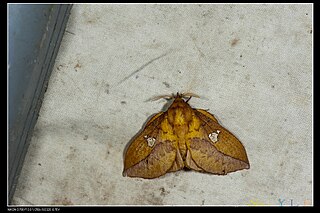
Euthrix laeta is a moth of the family Lasiocampidae first described by Francis Walker in 1855.
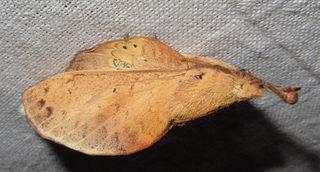
Gastropacha pardale, the brown lapped moth, is a moth of the family Lasiocampidae. The species was first described by Francis Walker in 1855.
Streblote dorsalis is a moth of the family Lasiocampidae first described by Francis Walker in 1866. It is found in India, Sri Lanka, the Philippines, Borneo, Indonesia and Java.
Episparis liturata is a moth of the family Noctuidae first described by George Hampson in 1893. It is found in India, Sri Lanka, Java, Borneo, Myanmar, China and Thailand.
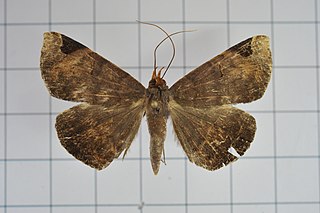
Mecodina praecipua is a moth of the family Noctuidae first described by Francis Walker in 1865.
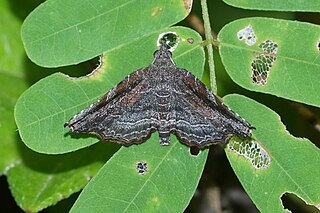
Nagadeba indecoralis is a moth of the family Noctuidae first described by Francis Walker in 1865. It is found in Sri Lanka, Java, India, Myanmar, India's Andaman Islands, Japan and Taiwan.
Saroba maculicosta is a moth of the family Noctuidae first described by Francis Walker in 1865. It is found in Sundaland, the Philippines, Papuan region to Solomon islands and Sri Lanka.
Anomis combinans, the yellow-banded semi-looper moth, is a moth of the family Erebidae. The species was first described by Francis Walker in 1858. It is found in Australia, Sri Lanka, Borneo, New Guinea, Malaysia and Timor.
Laelia suffusa is a moth of the family Erebidae first described by George Hampson in 1893. It is found in Bangladesh, Sri Lanka, Java, East Indies, Sundaland, the Philippines and Sulawesi.
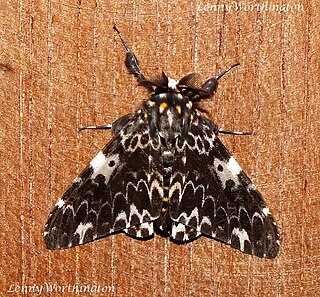
Lymantria marginata is a moth of the family Erebidae first described by Francis Walker in 1855. It is found in India, Bangladesh, Sri Lanka and Thailand.

Calletaera postvittata is a moth of the family Geometridae first described by Francis Walker in 1861. It is found in the Indian sub-region, Sri Lanka, Taiwan, and Sundaland.

Gonodontis clelia is a moth in the family Geometridae first described by Pieter Cramer in 1780. It is found in Sri Lanka, South India, Pakistan, Nepal, Hong Kong, the Andaman Islands, Singapore, Borneo and Australia.
Semiothisa ozararia, is a moth of the family Geometridae first described by Francis Walker in 1860. It is found in the Indian subregion, Sri Lanka, Taiwan, Borneo, Sumatra and Java.
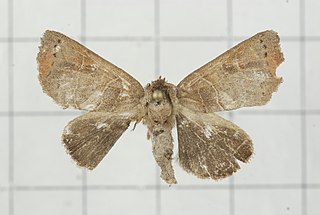
Clostera restitura is a moth of the family Notodontidae first described by Francis Walker in 1865. It is found in Oriental tropics of India, Sri Lanka, and from Hong Kong to Sundaland.

Polytela gloriosae, the Indian lily moth or lily caterpillar, is a moth of the family Noctuidae. The species was first described by Johan Christian Fabricius in 1781. It is found in Sri Lanka, India and probably in Indonesia.
Hypena mandatalis, is a moth of the family Erebidae first described by Francis Walker in 1859. It is found in the Indian subregion, Pakistan, Sri Lanka, Borneo, Sulawesi and Australia.
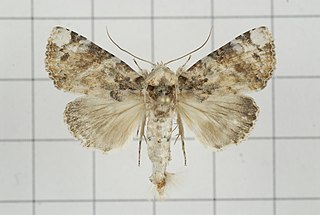
Beana terminigera is a moth of the family Nolidae first described by Francis Walker in 1858. It is found in India, Sri Lanka, Nepal, Thailand, Myanmar, Peninsular Malaysia, Borneo and the Philippines.












